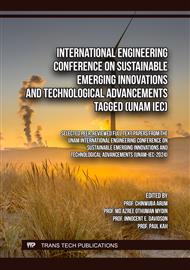[1]
World Bank, "Water Resources Management Overview." Accessed: Jun. 06, 2023. [Online]. Available: https://www.worldbank.org/en/topic/waterresourcesmanagement#2
Google Scholar
[2]
Y. Wang, T. Wan, and C. Tortajada, "Water demand framework and water development: The case of China," Water (Switzerland), vol. 10, no. 12, p.1–16, 2018.
DOI: 10.3390/w10121860
Google Scholar
[3]
J. Ithindi, N. Kgabi, E. Atekwana, M. Mathuthu, G. Kalumbu, and V. Tshivhase, "Radon, Salinity and Elemental Concentrations of Water Sources within the Kuiseb and Cuvelai-Etosha Basin, Namibia," Namibian Journal for Research, Science and Technology, vol. 1, no. 1, p.55–62, 2018.
DOI: 10.54421/njrst.v1i1.11
Google Scholar
[4]
H. Wanke et al., "The long road to sustainability: integrated water quality and quantity assessments in the Cuvelai-Etosha Basin, Namibia," Biodiversity & Ecology, vol. 6, p.32, 2018.
DOI: 10.7809/b-e.00307
Google Scholar
[5]
R. Arendt et al., "Natural pans as an important surface water resource in the cuvelai basin—metrics for storage volume calculations and identification of potential augmentation sites," Water (Switzerland), vol. 13, no. 2, 2021.
DOI: 10.3390/w13020177
Google Scholar
[6]
E. Niipare, "Assessment of floodwater harvesting infrastructures in the Namibian Cuvelai-Etosha basin," 2020.
Google Scholar
[7]
Census, "2023 Population & Housing Census Preliminary Report 2023 Population & Housing Census," 2023.
Google Scholar
[8]
J. Mendelsohn and B. Weber, The Cuvelai Basin its water and people in Angola. 2011.
Google Scholar
[9]
V. T. Shifidi, "Impact of flooding on rural livelihoods of the Cuvelai Basin in Northern Namibia," Journal of Geography and Regional Planning, vol. 9, no. 6, p.104–121, 2016.
DOI: 10.5897/jgrp2015.0536
Google Scholar
[10]
R. Arendt et al., "Natural pans as an important surface water resource in the cuvelai basin—metrics for storage volume calculations and identification of potential augmentation sites," Water (Switzerland), vol. 13, no. 2, 2021.
DOI: 10.3390/w13020177
Google Scholar
[11]
L. Drees, R. Luetkemeier, S. Liehr, and L. Stein, "Blended drought index: Integrated drought hazard assessment in the Cuvelai-Basin," Climate, vol. 5, no. 51, 2017.
DOI: 10.3390/cli5030051
Google Scholar
[12]
P. A. Dragnich, A. C. Dungca, N. L. Pendelton, and A. R. Tracy, "The Cuvelai-Etosha Basin Management Approach: Assessing Water Resource Management in the iishana Sub-Basin," 2007.
Google Scholar
[13]
MAWLR, "Water resources management regulations," Government Gazette, vol. 6105, no. 100, p.1–29, 2023.
Google Scholar
[14]
N. Bharti and D. Kathyal, "Water Quality Indices Used for Surface Water Vulnerability Assessment," Int J Environ Sci, vol. 2, no. 1, p.154–173, 2011.
Google Scholar
[15]
J. Ithindi, N. Kgabi, E. Atekwana, M. Mathuthu, G. Kalumbu, and V. Tshivhase, "Radon, Salinity and Elemental Concentrations of Water Sources within the Kuiseb and Cuvelai-Etosha Basin, Namibia," Namibian Journal for Research, Science and Technology, vol. 1, no. 1, p.55–62, 2018.
DOI: 10.54421/njrst.v1i1.11
Google Scholar
[16]
Indian Standard (BIS 10500), "WATER QUALITY STANDARDS," 1991. Accessed: Nov. 07, 2024. [Online]. Available: https://rwua.org.in/download/INDIAN%20STANDARD% 20FOR%20DRINKING%20WATER%20-%20SPECIFICATION%20IS%2010500% 20%201991.pdf
Google Scholar
[17]
M. Ahmed, R. Mumtaz, and Z. Anwar, "An Enhanced Water Quality Index for Water Quality Monitoring Using Remote Sensing and Machine Learning," Applied Sciences, vol. 12, no. 24, p.12787, Dec. 2022.
DOI: 10.3390/app122412787
Google Scholar
[18]
I. P. Oboh and N. K. Egun, "Utilization of Water Quality Index (WQI) in Water Quality Assessment of Groundwater in Agbor Metropolis, Delta State Nigeria," International Science Technology Journal, vol. 10, p.48–55, 2017, [Online]. Available: https://pdfs.semanticscholar.org/5f3a/c516b304b507216f27bba393d877cf576ab9.pdf
Google Scholar
[19]
G. Sharma, R. Lata, N. Thakur, V. Bajala, J. C. Kuniyal, and K. Kumar, "Application of multivariate statistical analysis and water quality index for quality characterization of Parbati River, Northwestern Himalaya, India," Discover Water, vol. 1, no. 1, Sep. 2021.
DOI: 10.1007/s43832-021-00005-3
Google Scholar
[20]
R. Haingotseheno, R. J. Chrysostome, R. Robert, and A. R. Tojonirina, "Water Quality Index (Wqi) Calculation for the Evaluationof Physico-Chemical Quality of Rainwater Collected in Reservoirs Full of Sand(Rfs)," Ijariie, vol. 6, no. 6, p.1050–1061, 2020.
Google Scholar
[21]
I. P. Oboh and N. K. Egun, "Utilization of Water Quality Index (WQI) in Water Quality Assessment of Groundwater in Agbor Metropolis, Delta State Nigeria," International Science Technology Journal, vol. 10, p.48–55, 2017.
Google Scholar
[22]
V. Kothari, S. Vij, S. K. Sharma, and N. Gupta, "Correlation of various water quality parameters and water quality index of districts of Uttarakhand," Environmental and Sustainability Indicators, vol. 9, no. June 2020, p.100093, 2021.
DOI: 10.1016/j.indic.2020.100093
Google Scholar
[23]
R. Rajesh, L. Elango, and K. Brindha, Methods for assessing the groundwater quality. Elsevier Inc., 2019.
DOI: 10.1016/B978-0-12-815413-7.00006-7
Google Scholar
[24]
M. Mehdi, D. K. Hakim, A. Amina, and G. Nourredine, "Multivariate Statistical Analysis of Groundwater Quality of Hassi R'mel, Algeria," Journal of Ecological Engineering, vol. 24, no. 5, p.22–31, 2023.
DOI: 10.12911/22998993/161140
Google Scholar
[25]
A. Semar, H. Saibi, and A. Medjerab, "Contribution of multivariate statistical techniques in the hydrochemical evaluation of groundwater from the Ouargla phreatic aquifer in Algeria," Arabian Journal of Geosciences, vol. 6, no. 9, p.3427–3436, Sep. 2013.
DOI: 10.1007/s12517-012-0616-4
Google Scholar
[26]
MAWLR, "Water resources management regulations," Government Gazette, vol. 6105, no. 100, p.1–29, 2023.
Google Scholar
[27]
O. O. Amu, E. O. Amu, E. C. Igibah, and L. O. Agashua, "Human health risk evaluation of sodium and ironic elements variability in ground water: A case study of Abuja North, Nigeria," Fuel Communications, vol. 10, p.100041, Mar. 2022.
DOI: 10.1016/j.jfueco.2021.100041
Google Scholar
[28]
World Health Organization, Guidelines for Drinking Water Quality, vol. 55. 2011.
DOI: 10.5005/jp/books/11431_8
Google Scholar
[29]
D. Kumar et al., "Multi-ahead electrical conductivity forecasting of surface water based on machine learning algorithms," Appl Water Sci, vol. 13, no. 10, Oct. 2023.
DOI: 10.1007/s13201-023-02005-1
Google Scholar
[30]
R. T. Andriambinintsoa, H. Randriamahefa, J. C. Randriamboavonjy, and Rejo Robert, "WATER_QUALITY_INDEX__WQI__CALCULATION_FOR_THE_EVALUATION_OF_PHYSICO_CHEMICAL_QUALITY_OF_RAINWATER_COLLECTED_IN_RESERVOIRS_FULL_OF_SAND (RFS)," vol. 6, no. 6, 2020.
Google Scholar
[31]
L. Drees, R. Luetkemeier, S. Liehr, and L. Stein, "Blended drought index: Integrated drought hazard assessment in the Cuvelai-Basin," Climate, vol. 5, no. 51, 2017.
DOI: 10.3390/cli5030051
Google Scholar
[32]
MAWF, "A pre-feasibility study into: The augmentation of water supply to the central area of Namibia and the Cuvelai," 2014. Accessed: Mar. 15, 2023. [Online]. Available: http://the-eis.com/elibrary/sites/default/files/downloads/literature/2014_07_25_PART II_Cuvelai_Interim Report No_1.pdf
Google Scholar
[33]
J. Mendelsohn and B. Weber, The Cuvelai Basin its water and people in Angola. 2011.
Google Scholar


